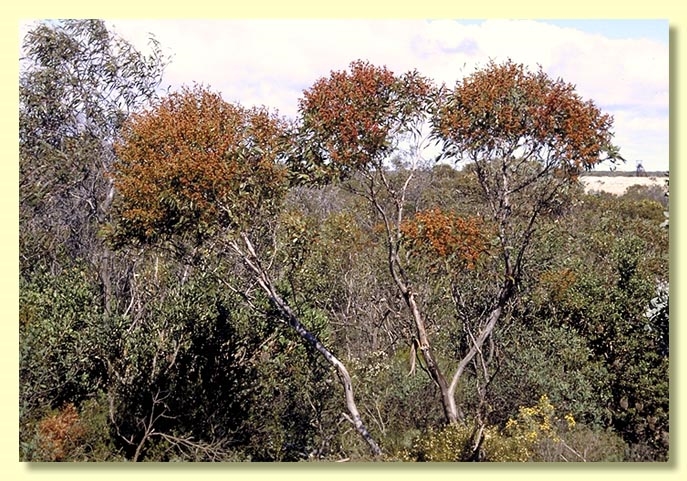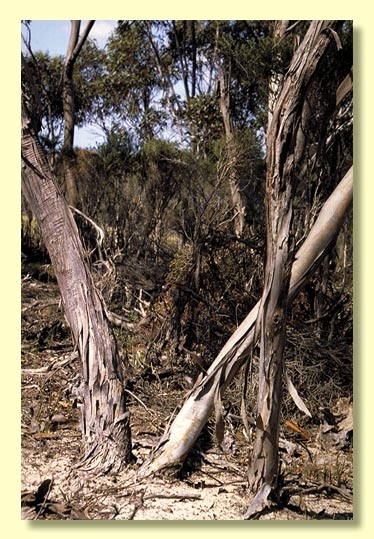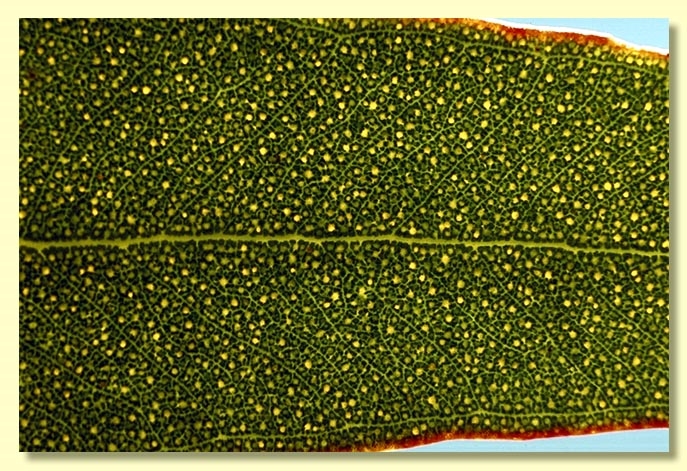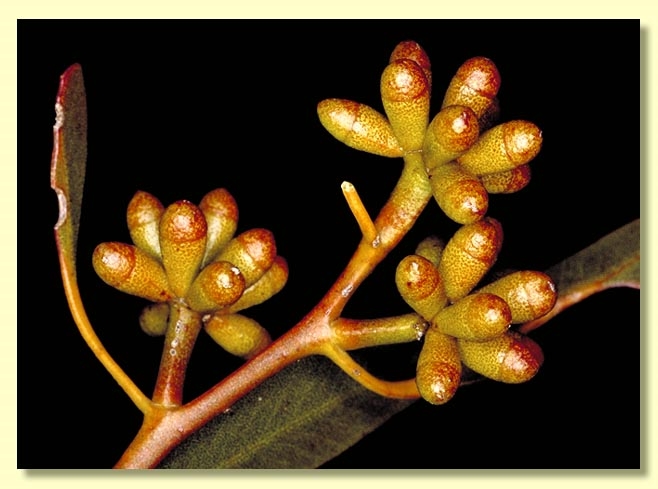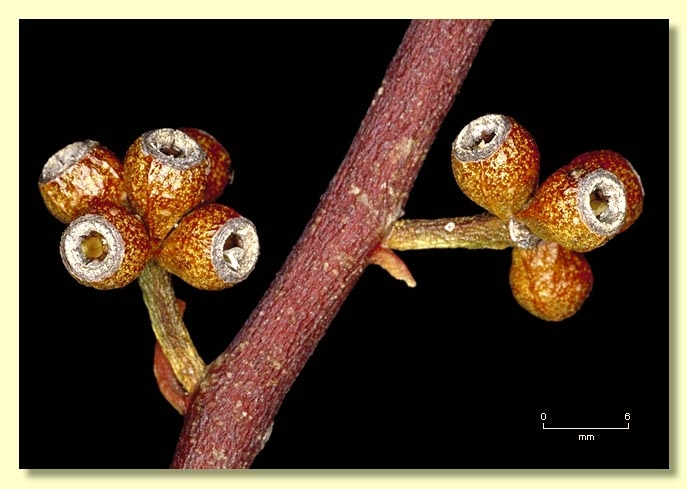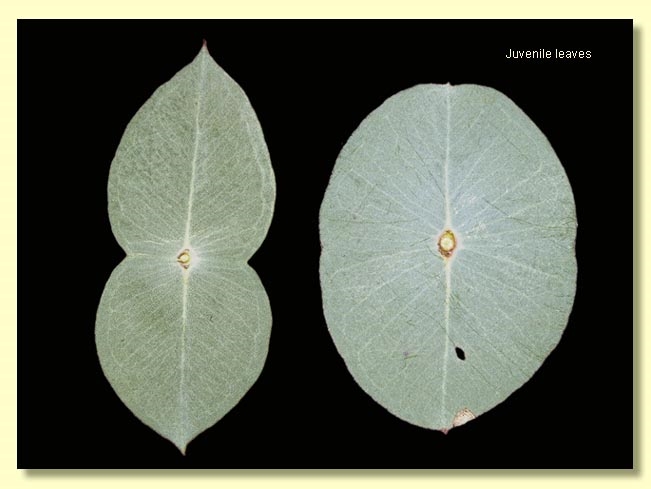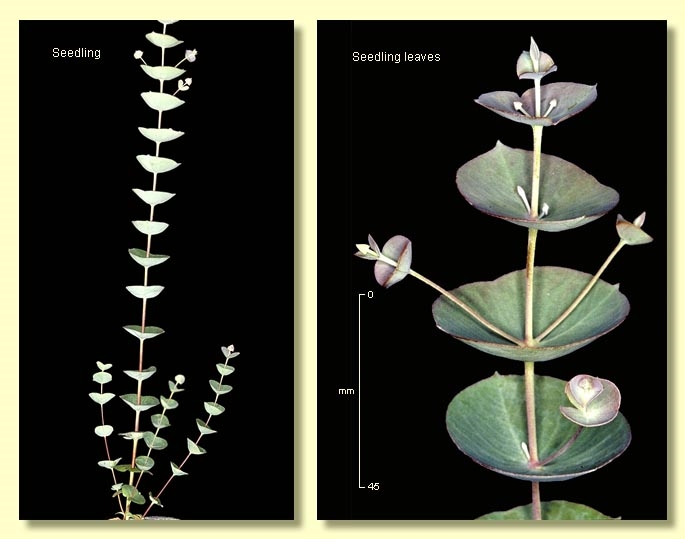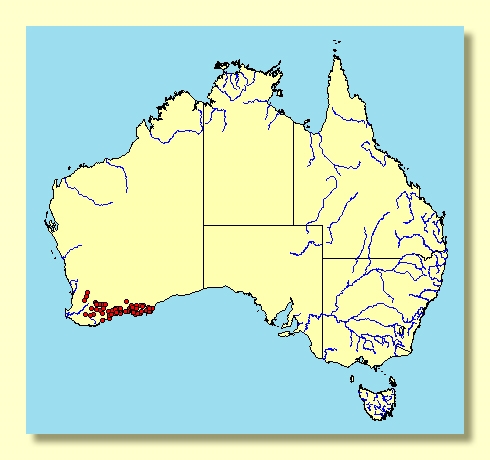Eucalyptus | Symphyomyrtus | Bisectae | Destitutae | Porantherae | Ovatae
Euclid - Online edition
Eucalyptus uncinata
Eucalyptus uncinata Turcz., Bull. Soc. Imp. Naturalistes Moscou 22(2): 23 (1849).
T: Swan R. Colony, W.A., 1845, J.Drummond 3: 66; holo: KW; iso: BM, FI, G, K, LE, MEL, NSW.
Eucalyptus uncinata var. latifolia Benth., Fl. Austral. 3: 216 (1867). T: Swan R. Colony, W.A., 1848, J.Drummond 4: 76; holo: K; iso: BM, CGE, FI, LE, NSW, PERTH.
Eucalyptus dumosa var. puncticulata Benth., Fl. Austral. 3: 230 (1867); E. puncticulata (Benth.) Blakely, Key Eucalypts 114 (1934). T: Gordon R., W.A., A.Oldfield s.n.; syn: K; Mt Barren Ranges, W.A., G.Maxwell s.n.; syn: herbarium of cited specimen unknown to us.
Eucalyptus desertorum Naudin, Descr. Emploi Eucalyptus intro. Europe 56 (18910. T: cultivated Villa Thuret, Antibes, France, 1889, M.Naudin s.n. ; syn: P.
Bark smooth throughout, white to cream over grey-brown shedding in short curly strips, or with a short basal stocking of rough fibrous grey-brown bark, which, in trees, may extend for 2–3 m up the trunk.
Branchlets lacking oil glands in the pith.
Juvenile growth (coppice or field seedlings to 50 cm): stems more or less rounded in cross-section, glaucous or not so; juvenile leaves opposite and with most bases connate for 10 or more nodes, upper nodes may have leaves with amplexicaul bases, individual leaf shape (half of connate pair) ovate-orbicular, 1.7–5.5 cm long, 1.7–5.5 cm wide, apex rounded-apiculate to pointed, bluish and often glaucous.
Adult leaves alternate, petioles 0.7–2.5 cm long; blade narrowly lanceolate to lanceolate, (5)6.5–11.5 cm long, (0.5)1–2.5 cm wide, base tapering to petiole, margin entire, apex pointed, concolorous, glossy green, side-veins at an acute or wider angle to midrib, reticulation dense or obscured by oil glands, intramarginal vein present, oil glands large, roundish, intersectional, numerous.
Inflorescence axillary unbranched, peduncles flattened to angular, 0.3–2 cm long, buds 9, 11 or 13, sessile to shortly pedicellate, pedicels 0–0.2 cm long. Mature buds obovoid to fusiform or ovoid (0.7–1.5 cm long, 0.3–0.5 cm wide), scar present, operculum conical or rounded (0.3–0.8 cm long), rarely beaked, stamens inflexed, anthers cuneate-cuboid, adnate to filament apex (rigidly basifixed), dehiscing by sub-terminal pores, a few of the innermost stamens imperfectly formed, style long and straight, rarely twisted apically, stigma tapered, locules 3(4), the placentae each with 4 vertical rows of ovules. Flowers creamy white.
Fruit usually sessile, rarely shortly pedicellate, pedicels 0–0.2 cm long, stoutly barrel-shaped to truncate-globose, 0.5–0.9 cm long, 0.4–0.8 cm wide, rim thick, disc whitish, descending, valves 3(4), more or less enclosed.
Seeds brown-grey, 1–2 mm long, flattened-ovoid, dorsal surface sometimes furrowed longitudinally, scarcely reticulate, hilum ventral.
Cultivated seedlings (measured at node 10): cotyledons Y-shaped (bisected); stems rounded in cross-section, glaucous or not; leaves opposite for at least 20 pairs with the leaf bases free for basal 3 to 10 nodes then becoming connate to varying degrees, often completely connate and the leaf pair like a saucer with the stem passing through the middle, sometimes like an eight in outline, dimensions of the leaf pair ca 3–7 cm long and 1.5–3.5 wide, apices rounded to pointed, strongly discolorous, green above and paler green or glaucous below.
Flowering has been recorded in January, February, March, April and November.
A common mallee or small tree endemic to Western Australia occurring on coastal and subcoastal sandplains eastwards from near York and Stirling Ranges east to Salmon Gums and near Israelite Bay. The stems are smooth in the common mallee form but rough in the lower half of the tree form found north-east of Esperance.
Eucalyptus uncinata belongs in Eucalyptus subgenus Symphyomyrtus section Bisectae subsection Destitutae because the buds have two opercula, cotyledons are Y-shaped and branchlets lack oil glands in the pith. Within this subsection E. uncinata is one of a group of about 16 species, series Porantherae, that are further characterised by having anthers completely adnate to the staminal filaments, strongly inflexed stamens, densely reticulate leaves with intersectional oil glands and by the fruit with a distinct thick rim that includes a whitish descending disc. The small, glossy leaves of species in series Porantherae may result in confusion with species in series Heterostemones. However, the fruit alone usually distinguish the series. The fruit of series Heterostemones are thin-rimmed.
E. uncinata is unique in series Porantherae because it has connate juvenile leaves. The buds and fruit are more or less sessile, a feature that is practically absent from other species in the series, although never as certainly diagnostic as the connate juvenile leaf pairs. The young inflorescences are often distinctive as they have conspicuous bracts that persist for some time during early bud development. Consequently the related species within the natural distribution of E. uncinata, viz. E. dissimulata, E. albida, E. discreta, E. perangusta, should not be confused with it.
The population in the Ravensthorpe Range, north of Ravensthorpe, has very coarse buds and fruit.

